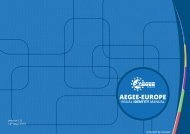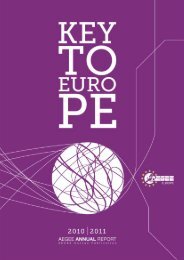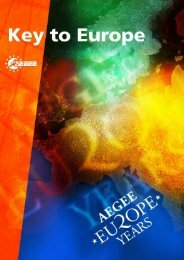turkish-greek civic dialogue - AEGEE Europe
turkish-greek civic dialogue - AEGEE Europe
turkish-greek civic dialogue - AEGEE Europe
You also want an ePaper? Increase the reach of your titles
YUMPU automatically turns print PDFs into web optimized ePapers that Google loves.
142<br />
constituted the centres of growth<br />
of a Minor Asiatic, of a refugee -<br />
if I can it call thus- culture. With<br />
this formulation I do not only mean<br />
the cuisine and the foods, I do not<br />
mean the songs, I do not mean<br />
the particularity of language, the<br />
customs, the house decoration, the<br />
gardens, etc. I mean another more<br />
general perception for life, another<br />
perception of culture itself.<br />
They developed an enormous collectiveness in their daily life, a collectiveness<br />
that was expressed outside their houses: in the squares, in the taverns, in<br />
their joints, but also in the pavements of their settlements. In the frame of<br />
the refugee’ settlements therefore was developed a folk like culture, an alive<br />
and extrovert culture, that it began from “Karagiozi” and reached to the habit<br />
to eat outside even the simple common daily persons. This culture began as<br />
refugee’ and progressively became Greek popular culture.<br />
However, in the émigré settlements progressively another perception of<br />
culture was shaped. Through official, national narration and the “national”<br />
civilization was risen a Greek Asia Minor, a nationalised Asia Minor that did not<br />
make anything other than to supply us with a Greek culture, homogeneous,<br />
diachronic and tragic, full of national pain, where the Turk was the sovereign<br />
rival form. Asia Minor of refugees was full of variegation, multi-religious<br />
aspects, multi-nationality.<br />
That Asia Minor was a world where a new horizon was opened: a horizon of<br />
cosmopolitanism, a horizon in the frame of which you could be a Greek and live<br />
peacefully together with a Turk without any problems.<br />
I was given birth in the first of the four émigrés settlements of Patras, roughly<br />
forty years after 1922. In my childhood but also in my adolescence many of<br />
the refugees of my first generation were still live, and I lived with them. My<br />
grandmother was from the Nikomidia, she came to Greece by the Asia Minor<br />
Tragedy, in 1922. My grandfather, from Ikonio, came with the population<br />
exchange, in 1924. To them and all the refugees of Patras I owe another Asia<br />
Minor. I owe another perception of life and culture.<br />
TURKISH-SPEAKING REFUGEES FROM PONT 2 IN GREECE:<br />
PROBLEMS OF INCORPORATION<br />
................................................................................................ by Nikos Marandzidis<br />
This particular article is supported in my older research that took the form of<br />
book was published in the Greek with the title “Jasasin Millet- Viva the Nation:<br />
refugees, possession and civilian, national identity and political behaviour<br />
in Turkish-speaking Greek orthodoxies the Western Pont”. The populations<br />
that the present work examines lives in the hinterland and in coastline of<br />
Western Pont, mainly in the administrative provinces the Sivas (Seva’steja),<br />
the Kastamonou and the Tsanik. According to Kitromilides and Alexandris, in<br />
1911 roughly 120.000 Greek that lived there spread in 336 unmixed Christian<br />
communities. From this population, the Turkish-speaking communities were<br />
246 and represented more than 80.000 persons. Turkish-speaking populations<br />
lived, also, in the limits of metropolis Neokaisareia (Niksar), which included, in<br />
1910, roughly 102.563 Greek Orthodoxies. The majority of these persons were<br />
living in rural communities, isolated from the rest of the world and with few<br />
contacts with the central authority. These persons were much attached to their<br />
region, in their village and in their mahalle (district).<br />
The language of an important part of the Christian population of Western Pont<br />
was Turkish. The use of the Turkish language, that was widespread and in other<br />
Christian Orthodox populations in the Asia Minor (Kappadokes), showed, after<br />
all, the limited effect of the educational institutions controlled by Greece<br />
that were implanted in these communities of Pont’s inhabitants. Generally,<br />
the distance that separated these populations from the intellectual centres of<br />
Hellenism appears to be big. It is characteristic that, while in Smyrni 13 Greek<br />
newspapers were being published in the dues of 19th century, in the Sevasteia<br />
and in the Kastamonou none was published.<br />
2 The term “Pontus” evolves from “Pont-Euxin”, which in ancient Greek denotes the Black Sea, the<br />
term currently refers to eastern Black Sea region of Turkey<br />
Population Exchange Association des Etats Généraux des Etudiants de L’<strong>Europe</strong>







